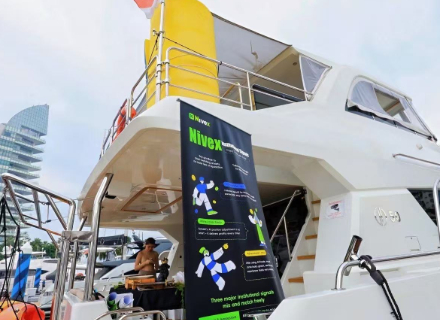Cardano's Governance Evolution: A Framework for Assessing Long-Term Value and Price Stability
- Cardano's three-tier governance model, ratified in 2025, enhances decentralization and institutional trust through stakeholder consensus. - U.S. Clarity Act reclassification as a "mature blockchain" boosted ADA's institutional adoption, including $1.2B reserve inclusion and 83% ETF approval odds. - $71M allocated to Hydra scaling solution (100k TPS) and 58% staked ADA demonstrate governance-driven technical progress and network resilience. - Key risks include regulatory uncertainty, Ethereum/Solana compe
Blockchain ecosystems are increasingly judged not just by their technological capabilities but by the robustness of their governance frameworks. Decentralized management structures, when designed effectively, can mitigate volatility, attract institutional capital, and foster long-term value creation. Cardano (ADA), a third-generation blockchain, has emerged as a case study in this dynamic, with recent governance milestones and decentralization trends reshaping investor sentiment and price trajectories.
Governance as a Catalyst for Institutional Confidence
Cardano's governance model, formalized in February 2025 with the ratification of its constitution, represents a structured, three-tiered approval system requiring consensus from Decentralized Representatives (DReps), Stake Pool Operators (SPOs), and the Constitutional Committee. This framework minimizes centralization risks while ensuring decisions reflect broad stakeholder interests. The introduction of 14 open-source governance lifecycle flowcharts in August 2025 further enhanced transparency, reducing uncertainty for investors and participants.
Institutional trust has been a direct beneficiary. The U.S. Clarity Act, enacted in early 2025, reclassified Cardano as a “mature blockchain” and a commodity, aligning it with Bitcoin and Ethereum . This regulatory clarity spurred ADA's inclusion in a $1.2 billion digital asset reserve and elevated the Grayscale ADA ETF's approval probability to 83% on Polymarket. These developments underscore how governance maturity can act as a magnet for institutional capital, which in turn funds further technical upgrades like Hydra and Ouroboros Leios.
Decentralization and the Flywheel Effect
Cardano's governance-driven flywheel effect is gaining momentum. Institutional trust attracts capital, which is then reinvested into governance and technical development. For instance, $71 million was allocated in August 2025 to accelerate Hydra, a Layer-2 scaling solution that demonstrated 100,000 TPS in testnets. This virtuous cycle not only strengthens ADA's technical foundation but also positions it to compete with high-performance chains like Solana .
Decentralization metrics further reinforce this narrative. Over 1,200 stake pools and 58% staked ADA (21.9 billion tokens) reflect a resilient network. The registration of Everstake as a DRep in August 2025 added institutional-grade governance expertise, validating Cardano's model. Meanwhile, projects like Veridian—a privacy-preserving credential verification platform—demonstrate how governance frameworks can drive real-world utility, attracting enterprise adoption in sectors like healthcare and supply chain.
Risks and Macroeconomic Considerations
Despite these positives, challenges persist. Regulatory risks, macroeconomic volatility, and competition from Ethereum and Solana remain headwinds. ADA's price, currently testing $0.74, faces key resistance levels. A sustained institutional buying spree, particularly if the Grayscale ETF is approved and Hydra's mainnet launches in Q1 2026, could propel ADA above $0.75. However, investors must remain cautious about broader market cycles, as ADA's price still exhibits a moderate correlation with Bitcoin.
Strategic Investment Implications
For investors, Cardano's governance-first strategy offers a compelling case. The platform's alignment with regulatory frameworks, institutional adoption, and technical execution creates a durable foundation. However, the path to long-term value requires patience. Key catalysts to monitor include:
1. Hydra's mainnet launch in early 2026, which could unlock enterprise scalability.
2. Grayscale ADA ETF approval, potentially broadening institutional access.
3. Regulatory developments in the U.S. and EU, which could further solidify Cardano's commodity status.
Investors should also consider diversifying exposure to Cardano's ecosystem projects, such as Veridian and Originate, which anchor ADA's utility beyond speculative trading. While the broader crypto market remains volatile, Cardano's governance maturity and institutional readiness position it as a resilient long-term asset.
In conclusion, Cardano's governance evolution exemplifies how decentralized management structures can stabilize price volatility and attract capital. By prioritizing transparency, institutional alignment, and real-world utility, ADA is well-positioned to navigate macroeconomic headwinds and emerge as a cornerstone of the next-generation blockchain landscape. For investors, the key lies in balancing optimism with prudence, leveraging governance-driven insights to navigate the crypto market's inherent uncertainties.
Disclaimer: The content of this article solely reflects the author's opinion and does not represent the platform in any capacity. This article is not intended to serve as a reference for making investment decisions.
You may also like
MicroStrategy Nears S&P 500 Entry After 70 Days of Qualification
Trump Family’s Crypto Profits Likely Exceed $1 Billion
Ethereum Could Be on the Verge of a Major Breakout, Analyst Says

Nivex SeaSpark Yacht Gala: Embracing the Future Wave of Socializing and Finance
Nivex held the SeaSpark VIP yacht event in Singapore, partnering with multiple Web3 companies to create a high-end maritime social experience and explore future connections between technology and finance. Summary generated by Mars AI. The accuracy and completeness of this summary are still being iteratively improved by the Mars AI model.
